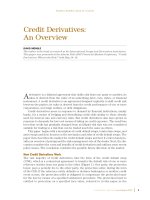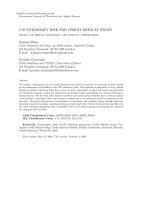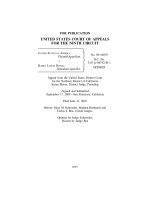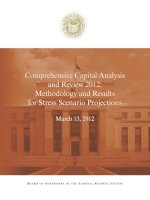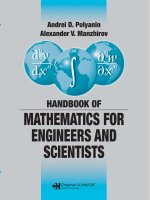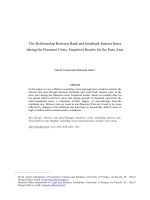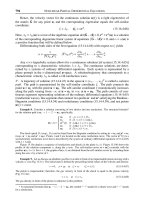Basic Mathematics for Economists - Rosser - Overview pptx
Bạn đang xem bản rút gọn của tài liệu. Xem và tải ngay bản đầy đủ của tài liệu tại đây (184.74 KB, 13 trang )
Basic Mathematics for Economists
Economics students will welcome the new edition of this excellent textbook. Given
that many students come into economics courses without having studied mathematics
for a number of years, this clearly written book will help to develop quantitative skills
in even the least numerate student up to the required level for a general Economics
or Business Studies course. All explanations of mathematical concepts are set out in
the context of applications in economics.
This new edition incorporates several new features, including new sections on:
• financial mathematics
• continuous growth
• matrix algebra
Improved pedagogical features, such as learning objectives and end of chapter ques-
tions, along with an overall example-led format and the use of Microsoft Excel for
relevant applications mean that this textbook will continue to be a popular choice for
both students and their lecturers.
Mike Rosser is Principal Lecturer in Economics in the Business School at Coventry
University.
© 1993, 2003 Mike Rosser
Basic Mathematics for
Economists
Second Edition
Mike Rosser
© 1993, 2003 Mike Rosser
First edition published 1993
by Routledge
This edition published 2003
by Routledge
11 New Fetter Lane, London EC4P 4EE
Simultaneously published in the USA and Canada
by Routledge
29 West 35th Street, New York, NY 10001
Routledge is an imprint of the Taylor & Francis Group
© 1993, 2003 Mike Rosser
All rights reserved. No part of this book may be reprinted or reproduced or
utilised in any form or by any electronic, mechanical, or other means, now
known or hereafter invented, including photocopying and recording, or in any
information storage or retrieval system, without permission in writing from
the publishers.
British Library Cataloguing in Publication Data
A catalogue record for this book is available from the British Library
Library of Congress Cataloging in Publication Data
A catalog record for this book has been requested
ISBN 0–415–26783–8 (hbk)
ISBN 0–415–26784–6 (pbk)
This edition published in the Taylor & Francis e-Library, 2003.
ISBN 0-203-42263-5 Master e-book ISBN
ISBN 0-203-42439-5 (Adobe eReader Format)
© 1993, 2003 Mike Rosser
Contents
Preface
Preface to Second Edition
Acknowledgements
1 Introduction
1.1 Why study mathematics?
1.2 Calculators and computers
1.3 Using the book
2 Arithmetic
2.1 Revision of basic concepts
2.2 Multiple operations
2.3 Brackets
2.4 Fractions
2.5 Elasticity of demand
2.6 Decimals
2.7 Negative numbers
2.8 Powers
2.9 Roots and fractional powers
2.10 Logarithms
3 Introduction to algebra
3.1 Representation
3.2 Evaluation
3.3 Simplification: addition and subtraction
3.4 Simplification: multiplication
3.5 Simplification: factorizing
3.6 Simplification: division
3.7 Solving simple equations
3.8 The summation sign
3.9 Inequality signs
© 1993, 2003 Mike Rosser
4 Graphs and functions
4.1 Functions
4.2 Inverse functions
4.3 Graphs of linear functions
4.4 Fitting linear functions
4.5 Slope
4.6 Budget constraints
4.7 Non-linear functions
4.8 Composite functions
4.9 Using Excel to plot functions
4.10 Functions with two independent variables
4.11 Summing functions horizontally
5 Linear equations
5.1 Simultaneous linear equation systems
5.2 Solving simultaneous linear equations
5.3 Graphical solution
5.4 Equating to same variable
5.5 Substitution
5.6 Row operations
5.7 More than two unknowns
5.8 Which method?
5.9 Comparative statics and the reduced form of
an economic model
5.10 Price discrimination
5.11 Multiplant monopoly
Appendix: linear programming
6 Quadratic equations
6.1 Solving quadratic equations
6.2 Graphical solution
6.3 Factorization
6.4 The quadratic formula
6.5 Quadratic simultaneous equations
6.6 Polynomials
7 Financial mathematics: series, time and investment
7.1 Discrete and continuous growth
7.2 Interest
7.3 Part year investment and the annual equivalent rate
7.4 Time periods, initial amounts and interest rates
7.5 Investment appraisal: net present value
7.6 The internal rate of return
7.7 Geometric series and annuities
© 1993, 2003 Mike Rosser
7.8 Perpetual annuities
7.9 Loan repayments
7.10 Other applications of growth and decline
8 Introduction to calculus
8.1 The differential calculus
8.2 Rules for differentiation
8.3 Marginal revenue and total revenue
8.4 Marginal cost and total cost
8.5 Profit maximization
8.6 Respecifying functions
8.7 Point elasticity of demand
8.8 Tax yield
8.9 The Keynesian multiplier
9 Unconstrained optimization
9.1 First-order conditions for a maximum
9.2 Second-order condition for a maximum
9.3 Second-order condition for a minimum
9.4 Summary of second-order conditions
9.5 Profit maximization
9.6 Inventory control
9.7 Comparative static effects of taxes
10 Partial differentiation
10.1 Partial differentiation and the marginal product
10.2 Further applications of partial differentiation
10.3 Second-order partial derivatives
10.4 Unconstrained optimization: functions with two variables
10.5 Total differentials and total derivatives
11 Constrained optimization
11.1 Constrained optimization and resource allocation
11.2 Constrained optimization by substitution
11.3 The Lagrange multiplier: constrained maximization
with two variables
11.4 The Lagrange multiplier: second-order conditions
11.5 Constrained minimization using the Lagrange multiplier
11.6 Constrained optimization with more than two variables
12 Further topics in calculus
12.1 Overview
12.2 The chain rule
12.3 The product rule
12.4 The quotient rule
© 1993, 2003 Mike Rosser
12.5 Individual labour supply
12.6 Integration
12.7 Definite integrals
13 Dynamics and difference equations
13.1 Dynamic economic analysis
13.2 The cobweb: iterative solutions
13.3 The cobweb: difference equation solutions
13.4 The lagged Keynesian macroeconomic model
13.5 Duopoly price adjustment
14 Exponential functions, continuous growth and
differential equations
14.1 Continuous growth and the exponential function
14.2 Accumulated final values after continuous growth
14.3 Continuous growth rates and initial amounts
14.4 Natural logarithms
14.5 Differentiation of logarithmic functions
14.6 Continuous time and differential equations
14.7 Solution of homogeneous differential equations
14.8 Solution of non-homogeneous differential equations
14.9 Continuous adjustment of market price
14.10 Continuous adjustment in a Keynesian macroeconomic model
15 Matrix algebra
15.1 Introduction to matrices and vectors
15.2 Basic principles of matrix multiplication
15.3 Matrix multiplication – the general case
15.4 The matrix inverse and the solution of
simultaneous equations
15.5 Determinants
15.6 Minors, cofactors and the Laplace expansion
15.7 The transpose matrix, the cofactor matrix, the adjoint
and the matrix inverse formula
15.8 Application of the matrix inverse to the solution of
linear simultaneous equations
15.9 Cramer’s rule
15.10 Second-order conditions and the Hessian matrix
15.11 Constrained optimization and the bordered Hessian
Answers
Symbols and terminology
© 1993, 2003 Mike Rosser
Preface
Over half of the students who enrol on economics degree courses have not studied mathe-
matics beyond GCSE or an equivalent level. These include many mature students whose last
encounter with algebra, or any other mathematics beyond basic arithmetic, is now a dim and
distant memory. It is mainly for these students that this book is intended. It aims to develop
their mathematical ability up to the level required for a general economics degree course (i.e.
one not specializing in mathematical economics) or for a modular degree course in economics
and related subjects, such as business studies. To achieve this aim it has several objectives.
First, it provides a revision of arithmetical and algebraic methods that students probably
studied at school but have now largely forgotten. It is a misconception to assume that, just
because a GCSE mathematics syllabus includes certain topics, students who passed exami-
nations on that syllabus two or more years ago are all still familiar with the material. They
usually require some revision exercises to jog their memories and to get into the habit of
using the different mathematical techniques again. The first few chapters are mainly devoted
to this revision, set out where possible in the context of applications in economics.
Second, this book introduces mathematical techniques that will be new to most students
throughexamplesoftheirapplicationtoeconomicconcepts.Italsotriestogetstudents
tackling problems in economics using these techniques as soon as possible so that they can
see how useful they are. Students are not required to work through unnecessary proofs, or
wrestle with complicated special cases that they are unlikely ever to encounter again. For
example, when covering the topic of calculus, some other textbooks require students to
plough through abstract theoretical applications of the technique of differentiation to every
conceivable type of function and special case before any mention of its uses in economics
is made. In this book, however, we introduce the basic concept of differentiation followed
byexamplesofeconomicapplicationsinChapter8.Furtherdevelopmentsofthetopic,
such as the second-order conditions for optimization, partial differentiation, and the rules
for differentiation of composite functions, are then gradually brought in over the next few
chapters, again in the context of economics application.
Third, this book tries to cover those mathematical techniques that will be relevant to stu-
dents’ economics degree programmes. Most applications are in the field of microeconomics,
rather than macroeconomics, given the increased emphasis on business economics within
manydegreecourses.Inparticular,Chapter7concentratesonanumberofmathematical
techniques that are relevant to finance and investment decision-making.
Given that most students now have access to computing facilities, ways of using a spread-
sheet package to solve certain problems that are extremely difficult or time-consuming to
solve manually are also explained.
© 1993, 2003 Mike Rosser
Although it starts at a gentle pace through fairly elementary material, so that the students
who gave up mathematics some years ago because they thought that they could not cope with
A-level maths are able to build up their confidence, this is not a watered-down ‘mathematics
without tears or effort’ type of textbook. As the book progresses the pace is increased and
students are expected to put in a serious amount of time and effort to master the material.
However, given the way in which this material is developed, it is hoped that students will be
motivated to do so. Not everyone finds mathematics easy, but at least it helps if you can see
the reason for having to study it.
© 1993, 2003 Mike Rosser
Preface to Second Edition
The approach and style of the first edition have proved popular with students and I have tried
to maintain both in the new material introduced in this second edition. The emphasis is on the
introduction of mathematical concepts in the context of economics applications, with each
step of the workings clearly explained in all the worked examples. Although the first edition
was originally aimed at less mathematically able students, many others have also found it
useful, some as a foundation for further study in mathematical economics and others as a
helpful reference for specific topics that they have had difficulty understanding.
The main changes introduced in this second edition are a new chapter on matrix algebra
(Chapter15)andarewriteofmostofChapter14,whichnowincludessectionsondifferential
equations and has been retitled ‘Exponential functions, continuous growth and differential
equations’. A new section on part-year investment has been added and the section on interest
ratesrewritteninChapter7,whichisnowcalled‘Financialmathematics–series,timeand
investment’. There are also new sections on the reduced form of an economic model and
thederivationofcomparativestaticpredictions,inChapter5usinglinearalgebra,andin
Chapter9usingcalculus.AllspreadsheetapplicationsarenowbasedonExcel,asthisisnow
the most commonly used spreadsheet program. Other minor changes and corrections have
been made throughout the rest of the book.
The Learning Objectives are now set out at the start of each chapter. It is hoped that students
will find these useful as a guide to what they should expect to achieve, and their lecturers
will find them useful when drawing up course guides. The layout of the pages in this second
edition is also an improvement on the rather cramped style of the first edition.
I hope that both students and their lecturers will find these changes helpful.
Mike Rosser
Coventry
© 1993, 2003 Mike Rosser
Acknowledgements
Microsoft
Windows and Microsoft
Excel
are registered trademarks of the Microsoft
Corporation. Screen shot(s) reprinted by permission from Microsoft Corporation.
I am still grateful to those who helped in the production of the first edition of this book,
including Joy Warren for her efficiency in typing the final manuscript, Mrs M. Fyvie and
Chandrika Chauhan for their help in typing earlier drafts, and Mick Hayes for his help in
checking the proofs.
The comments I have received from those people who have used the first edition have been
very helpful for the revisions and corrections made in this second edition. I would particularly
like to thank Alison Johnson at the Centre for International Studies in Economics, SOAS,
London, and Ray Lewis at the University of Adelaide, Australia, for their help in checking
the answers to the questions. I am also indebted to my colleague at Coventry, Keith Redhead,
for his advice on the revised chapter on financial mathematics, to Gurpreet Dosanjh for his
help in checking the second edition proofs, and to the two anonymous publisher’s referees
whose comments helped me to formulate this revised second edition.
Last, but certainly not least, I wish to acknowledge the help of my students in shaping
the way that this book was originally developed and has since been revised. I, of course, am
responsible for any remaining errors or omissions.
© 1993, 2003 Mike Rosser

